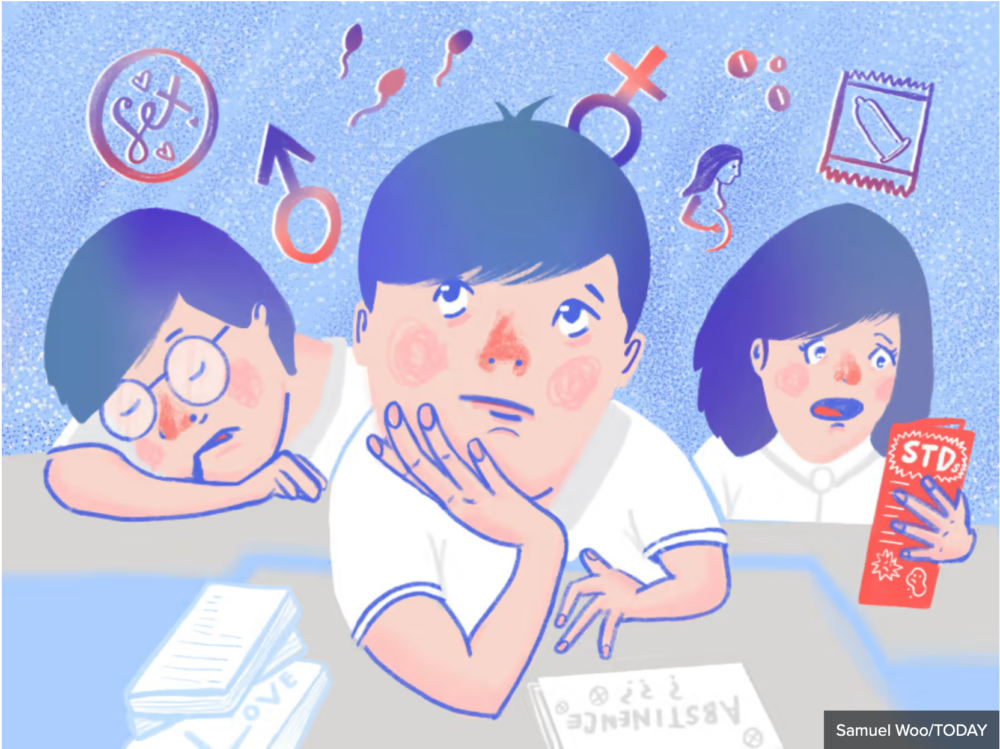
Image source: Today
There is no standardized way to have the “the birds and the bees” conversation. It is usually up to parents to decide how and when to have that talk with their children. However, I am someone who missed out entirely on that experience. It’s not that my parents viewed it as taboo, they just weren’t comfortable and had expected that I would learn about sex ed through school. My first memory of sexual health education was in the 5th grade. The teachers had separated the boys into one room and the girls into another. There was an old, small TV at the center of each classroom where a 30-minute video played discussing puberty for each gender. I remembered it being awkward and somewhat hard to follow because this was my first exposure to this information. The video discussed expectations for a menstrual cycle and anatomical changes, but that was all. My classmates were giggling and whispering, which shouldn’t be surprising for 10-11 year old’s. Though, clearly, there was little engagement with the material and likely little retention either.
While this topic is not a favorite of teachers or students, there is a need for effective and impactful sexual health education. In a Planned Parenthood poll, it was determined that 90% of parents are in support of sexual health education in middle and high school and that it should include a wide range of topics such as: STDs/STIs, HIV, birth control, identifying and navigating unhealthy relationships, abstinence, and sexual orientation (1). However, there are inconsistencies in the delivery and content of this information based on various states and school district policies. There are also other factors involved such as politics, religion, and culture that influence the ways this sex is discussed. The Centers for Disease Control and Prevention considers comprehensive sexual health education to be age-appropriate, medically accurate, and culturally relevant. Furthermore, the content and skills learned, target key behavioral outcomes and promote healthy sexual development (2). It also needs to be modified to include the needs of every student, specifically information relating to the LGBTQIA+ community. The importance of this knowledge is ultimately to keep students safer and give them the tools they need to make more informed decisions for their health.
By reducing any barriers to sexual health education, we are prioritizing healthier communities and significantly reducing life-altering outcomes of risky behaviors. The Center for Disease Control has found that by providing adequate sexual health education to students it can delay sexual behaviors, reduce unsafe practices, increase contraceptive methods, and improve academic performance (2). The steps needed to be taken to improve the delivery of sexual health education starts with engaging teachers and parents. Their support will create greater impact and help students better understand themselves and their peers. Comprehensive sexual education is most effective when it is taught by trained educators/adults and introduced at a young age. It is then reinforced and modified as kids grow and develop.
Schools are often prepared for typical academia, but there needs to be a stronger push for a standardized comprehensive sexual health curriculum. As someone that is interested in pursuing a career in sexual/reproductive health, I urge policy makers, educators, and parents to help bring momentum to this conversation. The future of our communities is our children, who deserve to be informed to keep themselves and others safe.
Sources:
1 – Planned Parenthood. (2014). Parents and teens talk about sexuality: a national survey. Planned Parenthood. https://www.plannedparenthood.org/uploads/filer_public/ac/50/ac50c2f7-cbc9-46b7-8531-ad3e92712016/nationalpoll_09-14_v2_1.pdf
2 – Centers for Disease Control and Prevention. (2023). What works in schools: Sexual health education. Centers for Disease Control and Prevention. https://www.cdc.gov/healthyyouth/whatworks/what-works-sexual-health-education.htm
By Sara Stevens, Associate Project Manager Intern, for HOP’s series of monthly staff blogs
